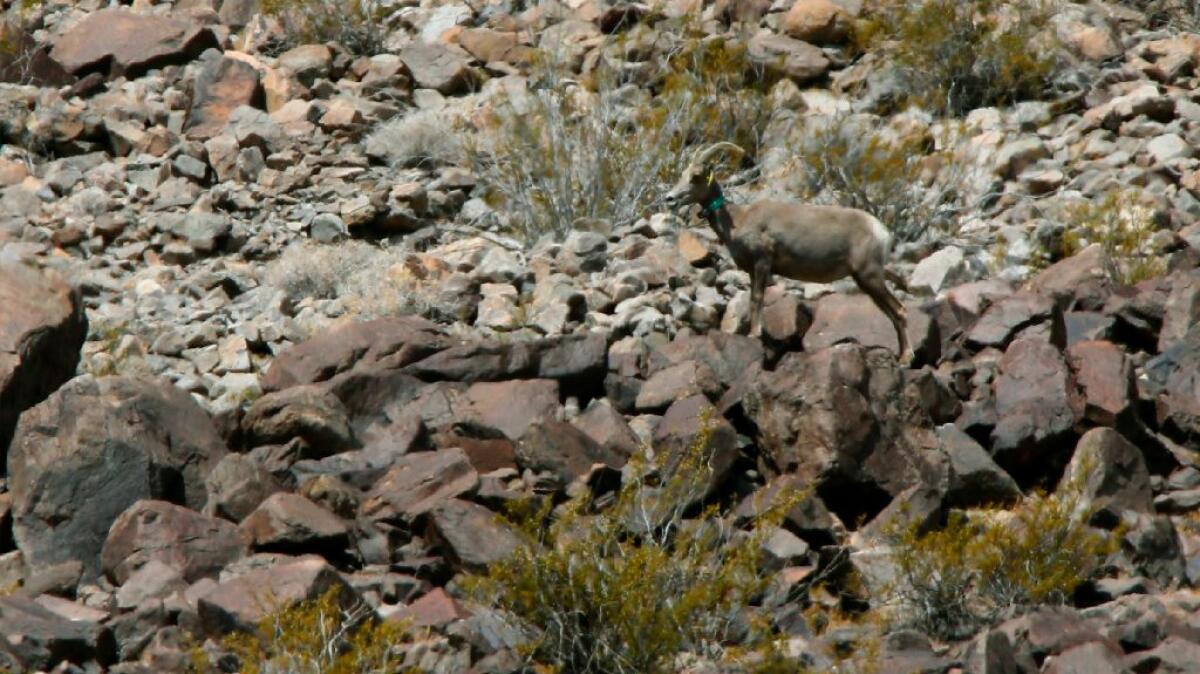San Bernardino County rejects a controversial solar power plant proposed for the Mojave Desert

- Share via
The San Bernardino County Board of Supervisors has rejected a controversial solar plant proposed for the Mojave Desert’s Soda Mountains, citing concerns that the project would destroy habitat and block ancient trails used by bighorn sheep for thousands of years.
In a 3-2 vote, the board on Tuesday declined to certify documents required under state law in order to issue county permits for the project on public land along Interstate 15 near the entrances to Joshua Tree National Park and Death Valley National Park, and less than a mile from the Mojave National Preserve.
“We endorse renewable energy, but this was the wrong project in the wrong location,” said Supervisor Robert A. Lovingood.
We remain committed to seeing the many benefits of Soda Mountain Solar through to fruition
— Reyad Fezzani, chairman and chief executive officer of Regenerate Power
“We have hundreds of miles of locations identified for such projects where the land is already disturbed and there are transmission lines,” said Lovingood, whose district includes the Soda Mountains. “When companies come forward with plans to build in those areas, we’ll support them.”
Menlo, Calif.-based Regenerate Power, which recently bought Soda Mountain Solar from Bechtel Corp., said it intends to overcome this latest obstacle and press forward with the project.
Reyad Fezzani, chairman and chief executive officer of Regenerate Power, suggested the supervisors’ action was motivated by “emotive arguments by opponents based on fear and misunderstanding.”
“We remain committed to seeing the many benefits of Soda Mountain Solar through to fruition, including hundreds of well-paying local union jobs, economic benefits to the county and local economy, and the production of clean solar energy to meet California’s growing demand,” he said.
The federal Bureau of Land Management had attempted to address environmental concerns by issuing a final environmental impact statement proposing to eliminate arrays of solar panels north of Interstate 15, reducing the photovoltaic facility’s size and lowering its output.
We endorse renewable energy, but this was the wrong project in the wrong location
— San Bernardino County Supervisor Robert A. Lovingood.
The decision angered environmentalists, who wanted the BLM and its parent agency, the Department of the Interior, to reject the project. Among other concerns, they noted the possible threat to bighorn sheep.
Biologists are attempting to reestablish key migration corridors for bighorn sheep separated from the north and south Soda Mountains by Interstate 15. Such connections would help ensure that bighorn sheep populations, which have experienced remarkable growth in recent years, do not become genetically isolated.
A year ago, the city of Los Angeles dropped plans to buy electricity from the 3-square-mile project, about 50 miles northeast of Barstow.
The decision was made after an L.A. Department of Water and Power review found that other proposed renewable energy projects would charge the city less for electricity and would have fewer challenges in delivering the power to Los Angeles.
Bechtel, developer of the plant at the time, had hoped that Los Angeles would buy most of the power, projected to have a capacity of about 264 megawatts.
David Lamfrom, an opponent of the project and spokesman for the nonprofit National Parks Conservation Assn., said, “the county supervisors did what the Interior Department would not; they denied the nation’s worst renewable energy proposal.”
ALSO
A dangerous confluence on the California coast: beach erosion and sea level rise
Illegal drugs are flowing into California’s most guarded prisons — and killing death row inmates
More to Read
Sign up for Essential California
The most important California stories and recommendations in your inbox every morning.
You may occasionally receive promotional content from the Los Angeles Times.











